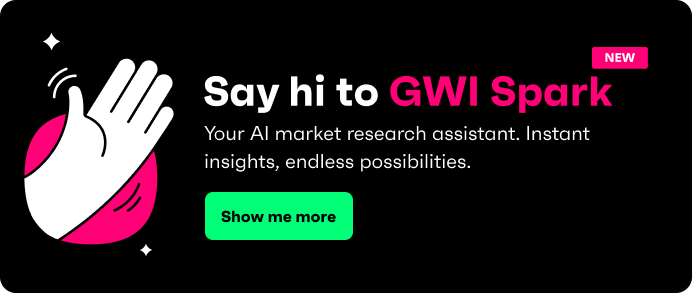3. They’re making tech-driven purchases
Millennials might still use “big internet” for high value purchases (on their laptops), but they’re also experiencing a growing reliance on mobile apps. It’s no real surprise given they’re the first generation to grow up with digital technology and the internet at their fingertips. Many millennials are happy to shop online - in fact, over 3 in 5 prefer it. They’re also comfortable shopping through social media channels and are 12% more likely to have used Instagram Shopping Bag in the past month, compared to the average Instagram user.
Millennials love the ease and functionality of using apps. In the last month alone, 1 in 5 millennials have paid for a mobile app, and they’re also 15% more likely than the average person to have used a bike or scooter app on their mobile in the last month.
Brands who offer seamless shopping experiences online across devices, including social shopping apps, are sure to win big with this tech-native generation.
4. They’re investing in their health and wellness
Millennials have always been known for prioritizing their mental health, but it seems they’re increasingly focusing on their physical health too. The number interested in fitness and exercise has increased 7% since 2021, and they’re more likely than other generations to take vitamins, minerals, and supplements when they’re feeling unwell.
But it doesn’t end there. While Gen Z might be the generation breaking up with diet culture, millennials are catching up - kind of. In the US, millennials are 56% more likely to shop at Whole Foods weekly compared to the average American. And on a global scale, 39% of millennials prefer food products that are organic, and 35% prefer foods high in protein. It seems like this generation are moving away from ultra-processed convenience and focusing on a fresher approach to their food.
Brands looking to connect with millennial consumers in this space should focus on the health and wellness benefits of their products, while being super clear on ingredients and how products are sourced.
5. They’re spending on their education
Millennials value success, and often the foundation for this lies in education, so it comes as no surprise that both formal education and continued learning are important to them.
Overall, 13% of millennials have paid for study programs or learning materials in the last month, indicating a sizeable investment in their education, and this figure is higher still in the Asia-Pacific region.
Brands offering the opportunity for millennials to invest in their personal growth, be that general education, or for professional development, are likely to get top marks with this audience.
6. They’re interested in crypto, stocks, and sustainable funds
Millennials are making their money work for them in different ways by looking at cryptocurrency, stocks, and shares. 12% of millennials own cryptocurrency, making them 20% more likely to own it than the average consumer. Plus, 21% of millennials own stocks and shares, making it the third most popular form of investment for this group.
It’s not just high-tech investments they’re making, some are going old school. The number of millennials who own gold as a type of saving or investment has grown 11% since 2021.
7. They prefer payment flexibility
“Buy now, pay later" isn’t just a snazzy slogan for flexible payments to millennials, it’s their main approach to spending. Globally, 63% of millennials have a credit card, and in Latin America, 31% of millennials prefer the ability to spread payments over time without added interest when shopping online - the highest of any region. This generation wants what they want, regardless of being able to pay for it outright.
Millennials are increasingly relying on BNPL services, and brands looking to attract these consumers need to recognize this by offering interest-free monthly payments for goods and services.
Implications for marketers and businesses
Connecting with millennials requires authenticity at every touchpoint. They value transparency and truthful storytelling, making it crucial for brands to communicate openly and align with their values.
Social media is where many millennials discover new brands, with 31% saying they discover brands through ads seen on social – up by 8% since 2020. Platforms like Instagram and TikTok aren’t just for scrolling; they’re key stages for influencer partnerships and brand engagement. Leveraging influencers who resonate with millennial values can help brands amplify their message and build trust.
Personalization is also paramount. Use quality consumer insights (like those in this blog) to tailor your messages, offers, and experiences to match the preferences of your audience. This not only captures their attention - it also drives loyalty.
Ecommerce optimization is another critical area to look at. Millennials demand seamless online shopping experiences, from intuitive site navigation to quick and easy checkout. Speedy delivery options are also a significant draw, often tipping the scales in favor of one retailer over another.
Loyalty programs aimed at millennials should also reflect their preferences. Traditional point-based systems might not cut it anymore, so instead, focus on rewards that matter to them, like exclusive experiences, or personalized offers.
Brands that understand and adapt to these spending habits and preferences will be better positioned to connect with millennials on a deeper level. By embracing authenticity, leveraging social media, personalizing experiences, and optimizing ecommerce buying journeys, businesses can create meaningful and lasting relationships with this influential demographic.
How to use GWI Spark to analyze millennial spending in seconds
Navigating the complex world of millennial spending habits can be a game-changer for your marketing strategies, and GWI Spark is here to make that journey smoother with AI-powered consumer insights. This powerful tool offers detailed insights into how millennials spend their money, from the brands they prefer to the values they prioritize.
Imagine uncovering that millennials are 29% more likely to have taken 9-10 vacations domestically in the past year after a single question - that's a goldmine of information for travel and hospitality marketers. You can tailor your campaigns to highlight domestic travel packages, leveraging this trend to capture millennial interest.
And let's not forget about financial behaviors. Millennials are navigating the financial landscape with a unique blend of traditional and innovative approaches. GWI Spark can help you understand their interest in cryptocurrencies, and other investment trends, enabling you to craft more compelling financial products and services.
With GWI Spark, you're not just collecting data; you're uncovering actionable insights that can transform your marketing efforts. Dive into the world of millennial spending and discover how you can better align your strategies with their evolving habits and preferences.
Key takeaways
Understanding millennial spending habits isn't just about knowing where they spend their money - it's about grasping the underlying values and motivations driving their choices.
As we look to the future, it's clear millennials' emphasis on experiences, and technology will continue to shape markets in profound ways. For marketers and businesses, it means creating campaigns that resonate on a deeper level, aligning with millennials' values and lifestyles.
This generation’s digital-first approach and value-driven spending patterns demand authenticity and adaptability from brands. Tailoring offers and experiences to meet millennial preferences can set a brand apart in a crowded marketplace. As they continue to prioritize health and wellness, businesses that can integrate these elements into their products and services authentically will find themselves ahead of the curve.






.webp?width=495&height=317&name=pink_thumb_graphs%20(1).webp)
.webp?width=495&height=317&name=pink_thumb_letter%20(2).webp)